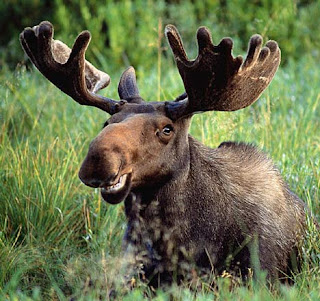Biography of the Moose
The Moose also known as elk. These are found in the cold plains of North America and Europe where they were named by locals as twig-eaters. The male have enormous antlers that the moose actually renews once a year. After the warmer mating season the male will shed its antlers to conserve energy for the winter. In the
springtime this animal begins to develop its new antlers which take from 3
to 5 months to fully grow.
The moose have been hunted by humans for both trophies but also for meat. They are also prey to a number of large carnivorous mammals which
they encounter such as bears, cougars and arctic wolves. There are
thought to be six different subspecies of animal found in the sub-arctic
forests today. These are the European moose (found in Finland, Sweden
and Norway), the Eastern moose (found in the east of Canada and northeast of the United States), the Western moose (found in the west of Canada), the Siberian moose (found in the east of Siberia and Mongolia), the Alaska moose (found in Alaska and Yukon) and the Shiras moose (found in Wyoming and Utah).
Life Cycle of Moose
Female moose do not have antlers and tend to give birth to the baby after
an 8 month gestation period. The female tends to have a single
calf but twins and triplets have been known. The fur of the baby
is a reddish colour that turns to brown as these get older. The young calves tend to stay with the mother until just before the next young are born.
Although moose are not
usually aggressive animals, particularly towards humans, when provoked, They have been known to attack humans. Although the consequences of their attack are generally minor, Animal have been known to attack more
humans than bears and wolves put together. They live in herds and live
until they are about 16 years old. Moose are herbivorous animals and spend their time foraging for vegetation and branches to munch on.












